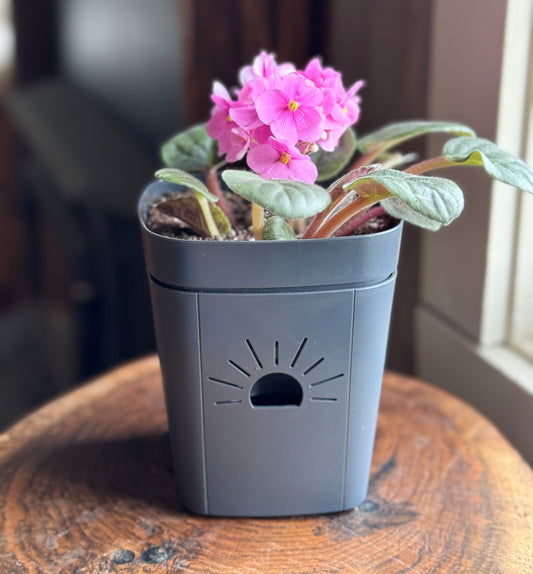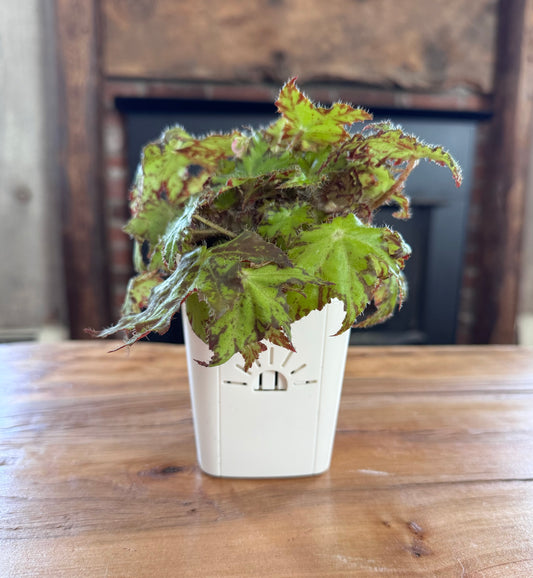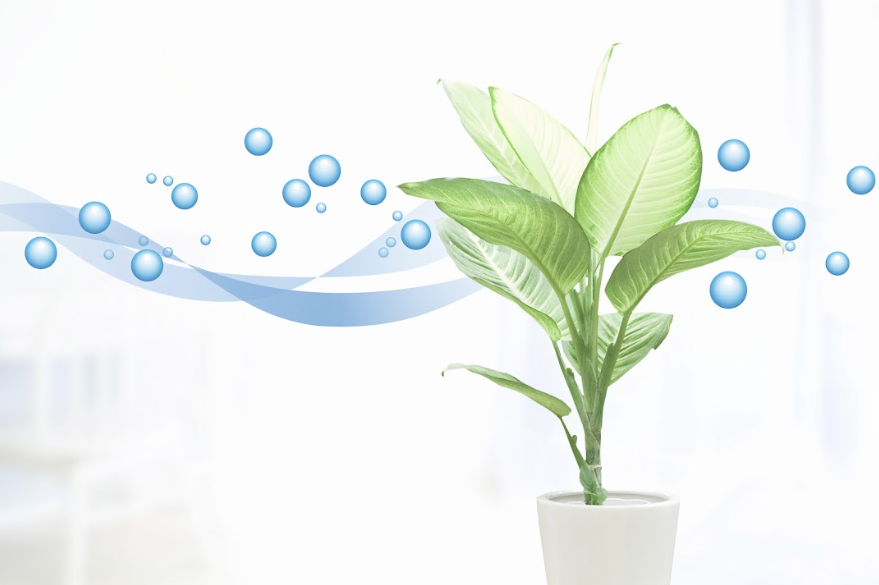Origins
Pilea is a genus of flowering plants that belongs to the nettle family and is found in tropical, subtropical, and warm temperate regions across South and Central America, Asia, Africa, and the Pacific Islands. To date, there are 787 published species. You can view them HERE.
These plants are relatively simple to cultivate and maintain and come in a diverse range of colors, shapes, and textures. In addition, they are renowned for being one of the easiest houseplants to propagate, and some even claim that caring for these plants brings luck.
Light
Requirements
Your Pilea will thrive best in bright, indirect light. Direct sunlight can damage its leaves, so it’s best to keep it a few feet away from a south-facing window. It will also be perfectly content in an east or west-facing window. Rotate the plant every two to three days to ensure it grows evenly. While it can grow in lower light, the leaves will become darker green, and the plant will spread out more. Be mindful of draughts when placing your Pilea near a window, as it does not do well in cold air.
Genus Summary
| GENUS | Pilea |
| COMMON NAMES | Chinese money plant, UFO plant, pancake plant, missionary plant. |
| LIGHT | Bright indirect light |
| WATER SCHEDULE | Naked Root = 14 days |
| WATER REQUIREMENTS | Conventional Planter, water when one inch of soil is dry. |
| HUMIDITY | Above 60 percent |
| TEMPERATURE | 60-80°F. Never below 55°F |
| FEEDING | 1x month |
| TOXICITY | Non-Toxic to humans and animals |
| PESTS | Aphids, spider mites, mealybugs, and scale |
| DISEASES | Root or stem rot, leaf-spot disease, powdery mildew, and botrytis |
| POT | A pot that allows for soil aeration |
| SOIL | 1 part pine bark, 1 part coconut coir, and one part perlite (or vermiculite). |
| FERTILIZER | Monthly 20-20-20 at half strength |
| PROPAGATION | By dividing offsets |
| PRUNING | Prune to prevent leggy growth |
| SIZE | Six to twelve inches |
Water Requirements
If using a Naked Root Planter, you can easily follow a 14-day watering schedule.
Check the top inch of soil with your finger to determine if your Pilea needs watering. Also, feel the leaves to see if they are thick or thin – if they do not feel plump, the plant is likely thirsty. If unsure, wait a bit longer and watch for signs of droopiness before giving it a drink.
It is important to adjust the amount of water given to the Pilea plant based on the external and internal temperature conditions. Generally, during the winter months, it is best to let the soil dry out for longer periods between each watering, while in the summer months, it might require more water. With time and patience, you will learn what works best for your plant.
Humidity
Pilea Peperomioides thrives in humid environments, and most of the time, our homes are too dry for them to survive. If you can increase the humidity in your house to 60 percent or higher, your Pilea will thank you.
Without enough humidity, you may notice the edges of the leaves turning brown and crisp, and new leaves won’t be able to grow properly. Just like how our skin gets dry in the winter, your Pilea will suffer in the dry air. To help your plant, don’t put it near any heat sources or drafts, and move it off of the floor and onto a table or stand away from doorways or corridors.
Temperature
When considering temperature, it is important to know that Pilea plants are tropical and do not prefer cold weather. They can tolerate temperatures as low as 55°F, but they thrive best in a range of 68-86°F. Ideally, the temperature should remain between 60-80°F all the time. To prevent damage to the plant, try not to expose it to temperatures below 55 °F or above 100 °F. Fluctuations in temperature can also be harmful, so try and keep your plant in an environment with consistent temperatures for optimal growth and health!
Toxicity
Pilea plants are generally considered non-toxic and safe for pets and people, so they don’t need to be kept out of reach or away from children and animals. However, it’s not recommended that you snack on them since they aren’t particularly appetizing! Pilea plants can still cause skin irritation in some people if touched, so it’s best to wear gloves when handling them and wash your hands afterward. If your pet does happen to eat a Pilea plant, there should be no adverse effects on their health. However, if any symptoms do occur, such as vomiting or diarrhea, then contact your vet immediately.
Pests and Diseases
Aphids, spider mites, mealybugs, and scale are all common pests that can affect Pilea plants. These pests can cause damage to the leaves of the plant, which will lead to a decrease in overall health. To prevent these issues, regularly inspect your plant for any signs of infestation and take action if necessary.
In addition to pest problems, Pilea is also susceptible to several diseases, including root or stem rot, leaf-spot disease, powdery mildew, and botrytis (grey mold). Root or stem rot occurs when the roots become too wet due to overwatering, and this results in stunted growth. Leaf-spot disease is caused by a fungus resulting in yellow spots on the leaves, which eventually turn brown before falling off. Powdery mildew appears as white patches on the surface of foliage, while grey mold develops as fuzzy grey patches, often accompanied by a musty smell. If you notice any of these symptoms, it’s important to act quickly to save your plant!
Pot
To ensure your Pilea plant is healthy and thriving, make sure the pot or soil has adequate drainage. Excess water needs to be able to drain away quickly. Otherwise, the plant may suffer from over-watering symptoms such as yellow leaves or root rot. To help with this, use well-draining soil and choose a pot with drainage holes. Additionally, small plants should not be placed in decorative outer pots because they will retain extra moisture, which could lead to more problems down the line. Soil aeration is essential for access to oxygen around its roots. Without enough oxygen in the soil surrounding its roots, it won’t be able to absorb water and nutrients properly, which will cause stunted growth.
Soil
Because Pilea roots absorb oxygen and release carbon dioxide, their growth can be hindered if the pot or the potting soil does not have enough oxygen. Poor oxygen absorption also leads to decreased water and nutrient intake. A great soil recipe for Pilea is 1 part pine bark, 1 part coconut coir, and one part perlite (or vermiculite).
Fertilizer
In order for plants to thrive, they need essential macro-nutrients, which come from air and water, plus nitrogen, phosphorus, and potassium, which you can provide with fertilizer. When looking at a fertilizer label, you will see three numbers such as 20-20-20, which indicates the ratio of nitrogen, phosphorus, and potassium contained in the product. To keep your Pilea healthy and vibrant, fertilize it every month with an all-purpose 20-20-20 fertilizer that is diluted to half-strength.
Propagation
Propagating Pilea plants is best done by cutting the offsets (smaller plants) out from the soil. You’ll need a knife, a potting mixture, a pot, and a container of water if you choose to propagate with water. Carefully remove the mother plant from its pot and locate an offset that is large enough to survive on its own (usually a few inches). Cut the portion of soil and roots around the smaller plant about one inch below the surface. If the baby’s roots are sufficiently developed, you can place them directly into moist soil. If the roots are less than a quarter inch long, let the plantlet sit in a glass of water until the roots grow longer.
Pruning
Before beginning, it is important to note that Pilea has delicate stems and is better suited to being pinched with fingers rather than using scissors. For added protection, it is recommended to wear gardening gloves when performing the task. Taking a closer look at your plant will help you determine which areas need trimming, such as overgrown leaves, dead stems, etc.
To start, take off any dead leaves that look brown or discolored. Use your thumb and index finger to pinch just above the node of the leaf and then pull to remove it. Take it slow and take breaks to make sure the Pilea is getting the right shape before continuing. If you want to trim the overgrowth, use sterilized pruning shears and cut the excess stem back by around a third. Cut at an angle of 45 degrees and as close to the primary stem of the plant as possible in order to stimulate new growth.
10 Striking Varieties and Cultivars
Pilea plants are easy to care for and easy to propagate. If you love plants that create offsets, giving you loads of free plants, you will love the Pilea. Here are a few of our favorite types.
Pilea Peperomioides – Pilea Peperomioides has recently become a popular choice among houseplant enthusiasts. It is easy to propagate, as it produces cuttings that can be shared with friends. This plant originated from the Yunnan province in China and was brought to Norway by missionary Agnar Espergren in the 1940s. He shared cuttings with his friends, and it became known as the Missionary Plant as it spread throughout Norway. Pilea Peperomioides have a unique, dome-like shape consisting of large, circular leaves that emerge from long stems. If rotated regularly, these plants will develop the classic round shape they are known for. Caring for Pilea Peperomioides is quite straightforward, as it is for most Pilea plants. The biggest risk to these plants is overwatering; if left sitting in damp soil for too long, the leaves may drop, and the plant may develop root rot.
Pilea Cadierei – Pilea Cadierei is a popular indoor plant native to Vietnam. It grows quickly and can reach 12-18″ in height, only able to be kept inside unless in a tropical climate. Caring for these Aluminum Plants is relatively easy, requiring little pruning and having few problems with pests. They prefer higher humidity, ideally around 70 percent or higher. Pilea Cadierei is distinctive for its oval-shaped leaves with a quilted silver pattern. To maintain its bright variegation, place it near enough to a south-facing window that it receives plenty of sunlight without being exposed to direct sunlight. It is also known for having a deep root system that may cause the pot to break if not given enough space.
Pilea Microphylla – The Artillery Plant, also known as the Pilea Microphylla, is a type of Pilea native to Mexico and Brazil that is not widely known as a houseplant but is able to thrive indoors with the proper humidity. This plant has small leaves that are round and plump, creating an umbrella-like canopy when spread out. The average Artillery Plant can grow up to 12″ tall. The Artillery Plant is sometimes referred to as the Artillery Fern, even though it isn’t a fern. The name is due to how it “shoots” its small green flowers and throw off pollen and seeds in a way that is similar to how an artillery shell is fired, which allows it to spread across a large space.
Pilea Nummulariifolia – Pilea nummulariifolia, more commonly referred to as Creeping Charlie, is a hardy plant that is simple to take care of and flourishes in hanging pots inside. This species is native to South America and the Caribbean and can become invasive when grown outdoors since it develops rapidly. Creeping Charlie is a low-growing vine that will attach to anything in its path. The leaves of Pilea Nummulariifolia are medium in size, shiny green, and have wavy edges. The veins are slightly indented, giving the leaves a full or wrinkled look. This type of Pilea tends to spread rapidly, so it must be trimmed back often to prevent it from taking over. When grown indoors, this plant prefers high moisture levels and works best in hanging baskets.
Pilea Depressa – Pilea Depressa is a popular choice for hanging baskets because of its stalks with many leaves that hang down. Its leaves are smaller than a pencil eraser and are bright green, round, and plump. Its stems are rigid and can be rooted at each node that touches the soil. It should be kept out of direct sunlight and requires very little pruning. Native to Mexico, Brazil, and the Caribbean, this plant is easy to care for and can tolerate any humidity levels. It is also known as Baby’s Tears.
Pilea Involucrara – This beloved plant has textured leaves with a fuzzy and quilted-like appearance and jagged edges. It often has bright green around the edges and dark burgundy or golden veins, while its underside is usually red or purple. Pilea Involucrata, or Friendship Plants, are a type of creeping plant that grows to an average height of eight inches tall. They need bright, indirect sunlight to stay healthy and should be placed near a sunny, south-facing window to get the best light. Pileas are sensitive to direct sun, so avoid this. These plants prefer to be kept in quick-draining soil and should only be watered when the soil is dry.
Pilea Mollis – Pilea Mollis, also known as Moon Valley Pilea, is a variation of the Involucrata. Its leaves are furry and maroon in color with lime green edges that seem to glow in the moonlight. The leaves are serrated around the edges, giving them a unique look. They require high humidity but are otherwise easy to take care of and will grow upright up to 12 inches tall. As long as they have enough water, sunlight, and humidity, they can thrive indoors or outdoors, making them an excellent choice for those looking for a low-maintenance plant that’s still visually interesting.
Pilea’ Dark Mystery’ – This unique houseplant has highly textured, chocolate-brown foliage with a distinctive silver streak running down the center of each leaf. Pilea’ Dark Mystery’ originates from Ecuador and boasts long, narrow leaves that are serrated like a lizard’s tail, with a wide silver strip in the middle. As it matures, new leaves emerge in red coloration. Its common name is Lizard Tails Pilea because of its appearance reminiscent of a reptilian appendage! It usually grows to six to eight inches tall and is an excellent addition to any indoor garden or terrarium setup. With proper care and attention, Pilea’ Dark Mystery’ will thrive for many years as part of your collection.
Pilea Libanensis – This particular type of Pilea is also known as Pilea Glauca. Its lush green foliage has silver-blue hues, making it a great option for hanging baskets. Its stems can grow up to six inches long, although it is a slow-growing plant, so patience is needed. Its leaves are small and egg-shaped. Young leaves have a greenish color, while mature ones are silver to gray in tone. The leaves are found in dense clusters and give the plant a trailing growth habit.
Pilea spruceana’ Silver Tree – The ‘Silver Tree’ Pilea has a striking appearance with its purple-brown leaves and a silver stripe down the middle. It should be kept in bright indirect light and should not receive any direct sunlight as it may get burned. When it comes to watering, it is important to never let the soil of this plant dry out completely. It has an upright, compact habit that grows up to 10 inches tall and wide, and its flowers are not very noticeable.
Summary of Pilea Plant Care
Pilea plants are rewarding and fun to grow, and easy to propagate. You can quickly end up with a dozen plants to give away to friends. Grow your Pilea in a Naked Root planter and water every 14 days, provide half-strength fertilizer every 30 days in spring and summer, and place your plant in bright, indirect light. Increase humidity to 60 percent or more and rotate your plant every few days for even growth.





 Verified Buyer
Verified Buyer









